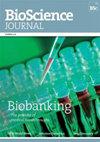Vertical migration of Haemonchus sp. infectant larvae on Stylosanthes spp. and Brachiaria brizantha (Syn. Urochloa brizantha) cv. Marandu forage
IF 0.6
4区 农林科学
Q3 AGRICULTURE, MULTIDISCIPLINARY
引用次数: 0
Abstract
The present work aimed to evaluate the influence of Stylosanthes spp. (Campo Grande© styles) and Brachiaria brizantha cv. Marandu in the vertical migration of Haemonchus spp. infective larvae, in the region of Uberlândia, Minas Gerais. Seeds of Stylosanthes spp. and Brachiaria brizantha cv. Marandu were planted in 50 pots of five liters (20 cm diameter) evenly disposed in an area of the Capim Branco Experimental Farm, Federal University of Uberlândia. When both species reached the minimum height of 20 cm, the pots were experimentally contaminated with sheep feces coprocultures. Samplings were performed, with complete removal of the vegetal material contained in the pots, on days one, three, six, 10 and 14 after contamination. Nematoids were recovered from the plant samples by thermo and hydrotropism, counted under an optical microscope and identified. For statistical analysis, the data were analyzed in a completely randomized design (DIC) in a 2X5 factorial scheme (two fodder species X 5 collection dates). No effect of the forage species was observed on the number of L3 of Haemonchus sp. recovered in the feces (p = 0.7790), upper stratum (p = 0.1755) or lower stratum (p = 0.7883) of the forage, however, there was a significant decrease in the number of L3 found with the passing of the days. When comparing the mean L3 recovered in the upper (0.06±0.31 L3) and lower (2.94±0.39) strata, a higher number of larvae was observed in the lower stratum (p < 0.0001). Therefore, in both forage species studied, the upper stratum of the plants, preferably pastured by the animals, remained with less contamination of infective larvae and the contamination tended to decrease over the days.血蜱幼虫在柱花草和棘臂线虫上的垂直迁移。Marandu饲料
本研究旨在评价柱花草属(Campo Grande©styles)和Brachiaria brizantha cv的影响。米纳斯吉拉斯州南印度地区血蜱感染幼虫垂直迁移的研究。柱花草属和花楸属种子。马兰度被种植在50个5升(直径20厘米)的花盆中,均匀地放置在印度联邦大学卡皮姆·布兰科实验农场的一个区域。当两种植物达到最小高度20 cm时,实验用羊粪粪污染花盆。在污染后的第1天、第3天、第6天、第10天和第14天进行取样,并完全去除罐中的植物物质。从植物样品中通过热性和亲水性回收线虫,在光学显微镜下计数并鉴定。为了进行统计分析,数据采用完全随机设计(DIC),采用2X5析因方案(两种饲料X5个采集日期)。饲料种类对血蜱粪便(p = 0.7790)、饲料上层(p = 0.1755)和饲料下层(p = 0.7883)中L3的数量没有影响,但随着饲养天数的增加,L3的数量显著减少。比较上层(0.06±0.31 L3)和下层(2.94±0.39)的平均L3,下层的幼虫数量较多(p < 0.0001)。因此,在研究的两种牧草中,植物的上层,最好是动物放牧,感染幼虫的污染较少,并且随着时间的推移,污染有减少的趋势。
本文章由计算机程序翻译,如有差异,请以英文原文为准。
求助全文
约1分钟内获得全文
求助全文
来源期刊

Bioscience Journal
Agricultural and Biological Sciences-General Agricultural and Biological Sciences
CiteScore
1.00
自引率
0.00%
发文量
90
审稿时长
48 weeks
期刊介绍:
The Bioscience Journal is an interdisciplinary electronic journal that publishes scientific articles in the areas of Agricultural Sciences, Biological Sciences and Health Sciences. Its mission is to disseminate new knowledge while contributing to the development of science in the country and in the world. The journal is published in a continuous flow, in English. The opinions and concepts expressed in the published articles are the sole responsibility of their authors.
 求助内容:
求助内容: 应助结果提醒方式:
应助结果提醒方式:


